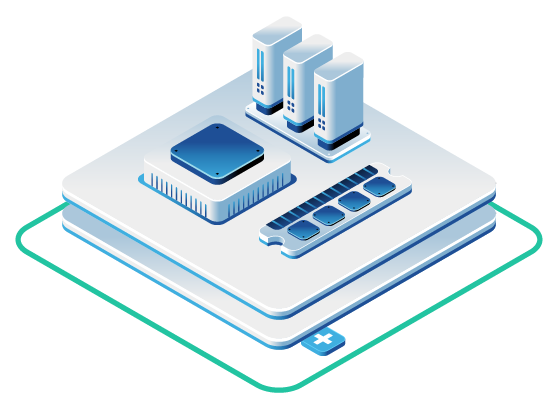In the landscape of big data analytics, Apache Spark has emerged as a powerful tool for in memory big data processing. The foundation for maximizing Spark’s capabilities lies in the infrastructure. OpenMetal’s XL V2.1 servers offer a solution that marries high performance with cost-effectiveness for Spark clusters.
Category: Blog
When it comes to processing big data, Hadoop clusters are a popular and mature open source system that enables businesses to analyze vast amounts of data efficiently.
That’s why our OpenMetal Storage XL V2 servers are designed to offer optimal performance for Hadoop environments.
Shopping around for a new cloud service provider (CSP) is an oft-daunting task that most companies will have to deal with at least once. Reaching out to multiple providers, gathering information, trying to ensure that you ask all the right questions to make a good comparison and find the right fit for your organization. It can quickly become a blur of information!
This article and accompanying downloadable aim to make this process a bit more organized! We’ve laid out various questions in different categories such as cost, capabilities, and support that you’ll likely want to ask every vendor you speak with.
Ready for a cost-efficient transition from AWS to your own data center? This blog covers everything your need to know including feature compatibility, team requirements for deployment and on-going management and insights into the initial deployment process.
When it comes to raw performance metrics, GPUs often lead the pack. Their architecture is specifically tailored for the high-speed, parallel processing demands of AI tasks. However, this doesn’t always translate into a one-size-fits-all solution.
In this article, we’ll explore scenarios where CPUs might not only compete but potentially gain an upper hand, focusing on cost, efficiency, and application-specific performance.
When considering OpenStack and Kubernetes, it is important to note that they do not compete with each other, rather, they are complementary projects. OpenStack is an infrastructure software, its priority is to manage your infrastructure resources such as virtual machines, networking services and storage.
The cloud has become a digital oasis, promising agility, scalability, and freedom from the shackles of on-premises infrastructure. But navigating it can be daunting, especially when faced with nearly unlimited cloud combinations – two of those being the choice between managed and hosted cloud services. Both offer the convenience of remote access and flexible resources, but beneath the surface lie distinct philosophies.
Cloud has matured dramatically in the last 10 years. In the beginning there were only a few cloud deployment model options. Today, in 2024, there are many easy and fast ways to get cloud. Let’s go through different cloud deployment models that are mature and provide a quality experience when measured against solid cloud native requirements.
In the realm of serverless computing, open source platforms like OpenFaaS, Knative, Nuclio, and Apache OpenWhisk have garnered significant attention and adoption within the developer community. Let’s compare these platforms and their use cases to find the best option.
Cloud cost optimization is the practice of efficiently managing the cost of your business’ cloud computing resources. An effective cloud cost optimization strategy ensures that your business gets the best value from its cloud investments. This strategy will find the right balance between performance, cost, compliance, and security for each workload or application your business has in the cloud.
Serverless computing offers a myriad of advantages but is not a universal solution. It represents a strategic choice, requiring careful consideration of application architecture, scalability needs, and financial models. If your business seeks an agile, cost-efficient, and scalable solution without the operational complexities of traditional server management, serverless computing might be the right path for your next project.
Considering a shift away from Google Cloud Platform (GCP)? While GCP is undeniably a major player in the cloud computing scene, the market is brimming with alternative solutions that might offer better value for your investment. With the increasing availability of cost-effective options, you might be questioning whether GCP aligns seamlessly with your current needs.
Is your organization prepared to harness the capabilities of cloud computing, yet unsure of where to begin? This blog will help anyone understand cloud computing and provides detail coverage of On-Prem, Public Cloud and Hosted Private Clouds.
In this video and accompanying article OpenMetal President, Todd Robinson, discusses with Jadon Naas, former Senior Product Engineer, who we believe may benefit most from OpenMetal on-demand private clouds.
Ready to explore the advantages of on-premises clouds alongside Todd Robinson, the President of OpenMetal? Under his guidance, delve into the details and acquire valuable insights on establishing your very own on-premises cloud. This information will empower you to seamlessly transfer workloads away from AWS with ease.
Learn how to create a DevOps culture in your workplace with this comprehensive guide. We cover everything from the basics of DevOps to tips for implementing it in your organization. With a DevOps culture, you can improve collaboration, communication, and efficiency, leading to faster and more reliable software releases.
Need cloud resources quickly but don’t want to add more workloads on costly public clouds? Keep reading this blog to learn more about On-Demand private clouds and how you can access resources on demand like with public clouds but have control over your bill and infrastructure like with private clouds.
In the beginning there were only a few cloud deployment model options. One of these, the public cloud deployment model, was dominant both marketing wise and in the quality of the cloud experience. Unless you were ok to wait for 4 to 12 months for a quality private cloud your only options was “to move to the cloud” at AWS.
Explore this comprehensive guide on how Chief Technology Officers (CTOs) and technical executives can harness the power of on-demand private clouds for their organizations. In this blog post, we’ll explore the insights about the benefits and strategies of leveraging on-demand private clouds provided by Todd Robinson, President of Open Metal.
High unpredictable cloud bills are leading more organizations to search for more cost effective infrastructure solutions. To stay ahead of the competition without hemorrhaging capital organizations need efficient, scalable and cost-effective cloud solutions. In this blog, we’ll explore what Proxmox and OpenStack are, with a high-level comparison to help you decide which solution is best for your organization’s needs.
CloudStack and OpenStack are two prominent open source solutions for cloud infrastructure management; understanding the key differences between them is crucial when choosing the right infrastructure for managing your workloads. In this blog, we will explore the differences between OpenStack and CloudStack, highlighting their strengths, weaknesses, and best use cases.
Many organizations are using Kubernetes to containerize their workloads because of the numerous benefits. These benefits include portability, scalability, reliability, automation and ecosystem. Running Kubernetes workloads on the wrong type of infrastructure can lead to a range of undesirable consequences such as: performance degradation, reliability issues, security vulnerabilities, and increased cost.
In this blog post, we’ll explore the key considerations you should keep in mind when choosing the right infrastructure to host your Kubernetes workloads.
OpenStack is one of the most popular open-source software solutions for cloud infrastructure. If you are tired of unpredictable public cloud bills or want more control over your infrastructure, you may be considering migrating workloads to an OpenStack cloud. Private OpenStack clouds are increasing in popularity as organizations seek to reduce cloud costs and have root level access to optimize their infrastructure for their workloads. This blog will cover everything you need to know about OpenStack and provide you with a step by step guide on how to get started on OpenStack.
Security and access control are paramount to ensure the safety of data and resources when using clouds. If you’re running workloads on OpenStack clouds, then you will find Keystone to be a crucial project that will play a significant role in managing authentication and authorization for your cloud. In this blog, we will dive deep into Keystone’s Role-Based Access Control (RBAC) process, its importance, and how it empowers a stateless and scalable cloud infrastructure.
As cloud became more and more popular in the last 10 years the definition of a private cloud versus a virtual private cloud became muddled. This article delves into the differences between the two and which is a better choice for your workloads.
The blog delves into the technical intricacies of OpenStack Swift, a versatile data storage solution, explaining its features, use cases, and functionalities. Picture a virtual universe where your crucial files are kept safe, accessible, and effortlessly organized. That’s the remarkable world of OpenStack Swift – a potent tool that not only secures your data but also streamlines its management. At its core, OpenStack Swift is like a friendly bridge that connects people like you and me with object storage
Artificial Intelligence (AI) and Machine Learning (ML) have been prominent topics within the technology landscape for an extended period. However, the emergence of AI such as OpenAI’s GPT-3 and Google Bard has elevated the excitement surrounding these advancements. GPT-3 stands as a language model capable of generating remarkably human-like text, garnering significant attention as a transformative force in the AI realm. Yet, how do these AI and ML technologies integrate with the realm of cloud computing? Moreover, what role do open-source cloud platforms like OpenStack play in propelling the progress of such sophisticated technologies?
Virtualization has revolutionized the way we use computer resources. One particular element is virtual GPU (vGPU) that has ability to deliver high-performance graphics and accelerate complex tasks. vGPU has become indispensable in industries like desktop virtualization (VDI) and remote workstations, ML/AI workloads, and scientific research. Within OpenStack clouds, the project Nova acts as a bridge between physical GPUs and the VMs that need GPU resources. Nova efficiently manages and allocates virtual GPUs. In this blog, we will explore Nova and vGPUs, their practical applications, and the process of setting up vGPUs with OpenStack Nova.
In this video and accompanying article, OpenMetal Infrastructure and Platform Automations Engineer, Yuriy Shyyan, delves into the challenges and opportunities faced by growing businesses when it comes to cloud infrastructure costs and vendor dependency. We present OpenStack and Ceph as powerful tools for creating personalized cloud environments. With OpenStack and Ceph, organizations can regain control over their infrastructure, extracting more value.
Ready to dive into the world of cloud computing but not sure which cloud computing platform is best to learn? With the ever-increasing demand for cloud computing skills, a career in cloud computing is a safe bet, but the decision of which platform to learn can be overwhelming for anyone planning a career in cloud computing. In this article, I will compare AWS vs Azure vs GCP vs OpenStack and explore their pros and cons can why you may want to pursue a career working on one of these cloud platforms.
This article defines big data and its applications, the big data solutions platform that process the data, and big data infrastructure requirements necessary to support operational efficiencies.
In this video and accompanying article OpenMetal’s Principal Engineer, Jacob Hipps, discusses various use-cases and considerations for utilizing vGPUs effectively in OpenStack Nova. This session was recorded at OpenInfra Summit 2023 in Vancouver.
The world-changing OpenStack cloud platform that we all know and love is celebrating its 13th birthday! Let’s reminisce on what it’s given us and ponder what lies ahead.
OpenMetal’s technical leadership had the opportunity to present talks/workshops at the OpenInfra Summit held in Vancouver in June 2023. This article provides a synopsis of those talks and has links to the recorded videos.
Based on OpenMetal’s experience working with higher learning organizations and direct independent market research, our team has found many universities and education institutions are using open-source technologies like OpenStack to achieve its IT objectives. In this blog post, we will explore the utilization of OpenStack by universities, delving into its advantages for these educational institutions. Additionally, we will provide guidance on how to initiate your journey with OpenStack.
In this article, we’ll delve into the advantages and disadvantages of GCP, and then highlight an alternative solution for businesses seeking flexibility and scalability.
Google Cloud Platform (GCP) is a prominent player in the cloud computing landscape. But, not without competition from other mega providers like AWS. With the recent rise in lower cost alternative solutions available, anyone considering GCP may wonder if they are getting the best value for their dollar. GCP like every platform has its pros and cons. And when considering committing to a cloud provider, it is best practice to thoroughly evaluate various options before committing.
Red Hat CentOS will now be the sole repository for public RHEL-related source code releases. Read our president’s response to this change and his view on possible paths forward for the open source community.
The adoption of Infrastructure-as-a-Service (IaaS) is on the rise as businesses seek to harness the scalability, flexibility, and cost-effectiveness of cloud computing. While virtualization has been a central component of IaaS, the integration of bare metal servers introduces a new dimension to infrastructure management.
This article defines big data and its applications, the big data solutions platform that process the data, and big data infrastructure requirements necessary to support operational efficiencies.
Ironic, a vital part of OpenStack, focuses on provisioning and managing bare metal servers. It seamlessly integrates with Keystone, Nova, Neutron, Glance, and Swift to provide a unified interface for managing hardware resources within a cloud environment. With Ironic, operators can treat physical servers like virtual machines, streamlining the management of resources in an OpenStack cloud. It simplifies bare metal management through a unified interface, seamless integration with OpenStack services, and automated provisioning.
AWS and GCP are leading players in cloud computing, offering a wide range of services and attractive pricing. However, choosing the right platform requires understanding their strengths, customer pain points, and alternatives. Comparing and shopping around for cloud products can be complex, with varying names and pricing structures. Transparent pricing is crucial, but some providers could improve in this area.
Octavia is an open-source load balancing solution designed for use with OpenStack. Octavia distinguishes itself by dynamically scaling up a fleet of virtual machines, containers, or bare metal servers, known as amphorae, to deliver load balancing services as needed. This on-demand horizontal scaling capability makes Octavia well-suited for cloud environments.
In the realm of deploying Kubernetes on OpenStack, Rancher stands out as the best tool available. Its comprehensive feature set, ease of use, and hybrid capabilities make it an excellent choice for organizations seeking to manage Kubernetes clusters seamlessly.
Cloud computing has revolutionized the way organizations access and manage their IT resources. With its numerous benefits such as cost-effectiveness, scalability, and global reach, organizations can focus on their core operations while leaving infrastructure management to cloud service providers.
As on demand cloud computing choices have grown, so have customer options for how to purchase those clouds. It’s not uncommon for public clouds to offer self-service tools or a cloud hosting trial. But it is not as common for private or open source clouds. In this post, we’ll explore the benefits of using self-service tools to now buy hosted private cloud services online and how they can make the process more efficient.
Learn about OpenMetal Cloud’s outlook on incorporating serverless architecture into our hosted private cloud offerings.
Learn how OpenStack supports running geographically separated OpenStacks from one central command OpenStack.
OpenMetal CEO, Todd Robinson, discusses with Mark Collier, COO of the OpenInfra Foundation, his vision for how OpenMetal Cloud can assist small businesses.
While Harvester, Nomad, and Kubernetes share many similar app native features, their deployment and management approaches, as well as additional capabilities like distributed computing, can influence the best fit for your specific use case within the context of OpenStack.
Where cloud computing has become a cornerstone of digital transformation, OpenStack stands out as a powerful and adaptable platform. Organizations across various sectors, from telecommunications giants to technology leaders, have embraced OpenStack to power their critical infrastructure and enable innovation.
Combining Microsoft and OpenStack offerings is a powerful way to provide flexible, cost-effective, and secure cloud computing solutions to your customers. By offering the best of both worlds, you can help your customers meet their specific business needs while also saving them (and yourself) money.
SaaS providers built success on their ability to deliver quality software and service reliability as cost-effectively as possible, to maintain competitive pricing and profitability. That is why SaaS providers typically take the popular option of hosting their services on public clouds. But SaaS providers may be overlooking a number of benefits that they could gain from choosing private cloud hosting.
Both Kubernetes and OpenShift are powerful cloud platforms with their strengths and weaknesses. When deciding between the two, it’s crucial to evaluate your business’s specific requirements, including your infrastructure, skill level, and budget.
If you’re searching for a solution to take full control of your infrastructure, you might have come across the term “open source cloud.” But what exactly is it? In this comprehensive blog, we’ll dive deep into the concept of open source clouds and explore why they are the ultimate key to empowering organizations.
More and more companies are facing the reality of high costs coming from their public cloud deployments on AWS, Azure, GCP and the other mega clouds. This has given rise to the concept of Cloud Repatriation.
Learn about deploying Kubernetes on OpenStack with Kubespray, Rancher, Portainer, and Kubeadm. We’ll help you decide which method is right for you.
A cloud migration strategy generally follows the “land and expand” or “lift and shift” method. However, a more flexible, hybrid approach is beneficial. By adopting a flexible cloud migration approach that combines elements of both strategies, organizations can better align migration efforts with their unique requirements and constraints.
Cloud infrastructure is a critical component for SaaS platform providers and, in many cases, the business’ highest operational cost. This article goes into some of the top concerns that SaaS platform providers have about their cloud infrastructure and how an open source IaaS platform like OpenMetal Cloud can help resolve some of these pain points.
SaaS Providers brave enough to go against norms are reevaluating AWS pros and cons and discovering new SaaS success on cloud alternatives such as hosted private cloud and open source solutions.
Learn about alternative cloud solutions that combine the best of both public and private clouds and give your business greater flexibility.
On-demand private clouds have emerged as a viable solution for businesses to reap the benefits of both reduced costs and enhanced flexibility. In this blog post, we’ll explore the evolution and benefits of on-demand private clouds and alternative cloud infrastructure solutions, and how they can maximize ROI for many businesses.
Tackle OpenStack implementation challenges with ease! Optimize your IT infrastructure while reducing dependency on mega cloud providers with our tips.
When SaaS providers consume large amounts of public cloud, a move to a hosted private cloud may reduce current AWS costs up to 50%. This can free up existing capital to be used for new SaaS growth.
OpenStack is a powerful cloud computing platform that is backed by a vast community of developers who continuously update and improve the software. In this blog, we will discuss OpenStack projects and open source software that can be used to create a cloud environment that’s ideal for building, testing, and managing AI.
As a public cloud or cloud hosting provider, you’re no stranger to the challenge of offering competitive and profitable solutions to your customers while simultaneously reducing your workload. One way to achieve this balance is by incorporating a customizable, easy-to-manage private cloud solution into your offerings without investing in extensive infrastructure resources or requiring additional maintenance work. Well say hello to OpenMetal Cloud for Hosting and Public Cloud Providers!
As businesses realize the growing costs of cloud, it becomes even more important to find alternative solutions.
This article presents the known benefits of private cloud, the factors that make organizations hesitant about the move, on-demand private cloud as the true alternative to public cloud, and also three business use cases that could reduce cloud spend while moving from a public cloud.
Kubernetes on OpenStack is a powerful combination. It helps organizations manage their applications and services. This power duo provides the flexibility to scale up or down as needed, while also allowing for easy deployment and management of applications. This is essential for an organizations success in today’s fast paced digital age where organizations must be able to deploy their applications quickly and efficiently, at scale, and across multiple environments.
OpenStack is undeniably a powerful and versatile cloud platform that many industries continue to adopt at an increasing rate. Obviously, we’re big fans! But, like any intricate technology, having a firm understanding of its inner workings is crucial for deriving maximum efficiency, especially if your business provides cloud or primarily online services. So today, we’ll be diving into the world of subscription ratios in OpenStack, which play a vital role in resource allocation across your infrastructure.
Private, hybrid, and open source cloud solutions offer managed IT service providers unparalleled control, customization, and security. While public cloud providers may have had their place in the growth of the cloud industry, it’s apparent that the future lies in more secure and flexible environments.
OpenShift is a powerful and flexible platform that can help you simplify the deployment and management of container-based applications, accelerate application delivery, and work with different types of infrastructure. If you’re looking for a comprehensive and easy-to-use platform for building and managing cloud-based applications, this offering is an excellent choice.
With public and private clouds as the traditional options, innovative alternative clouds have emerged and are making waves. Deciding which cloud to use for your organization requires careful consideration of factors such as your unique business needs, budget, security and compliance requirements, and other important factors.
With automation tools such as Terraform, Kolla Ansible and Heat, organizations can automate their OpenStack cloud operations and reduce the time and effort required to manage their cloud environment. When organizations automate many of the functions within their OpenStack cloud, they can benefit from increased agility, scalability, reliability, security, cost savings, and improved customer experience.
Effective cloud cost optimization will reduce unnecessary spending on cloud services, while still ensuring that the organization has access to the resources it needs. In this article, we’ll cover cloud cost management best practices and ways you can prevent spend from ballooning.
For small and medium sized organizations, high cloud spend is not something they can afford. And as time has passed and OpenStack has evolved, the barriers to getting started on OpenStack are lower and the savings make it hard to ignore.
A search on “public cloud advantages” will nearly always include some statements about public cloud being “less expensive” than alternatives. Unfortunately, this common narrative is simply not true for many situations!
More information about alternatives to public cloud is needed to help leaders in IT explain when public cloud is right or when private cloud, bare metal, colocation, or owned data centers are the right choice.
The first step for deciding to run Kubernetes is to first understand if your environment is ready to run it. After that, it’s all about figuring out where you want to run Kubernetes. From a reliability, security, and cost perspective, running Kubernetes on OpenStack is never a bad idea. In this blog post, you’re going to learn about the key reasons why you’d want to run Kubernetes clusters on OpenStack.
There are many OpenStack projects that you can use to build a cloud that can handle your use case and workloads. While OpenStack projects work well together, they also work with other popular software because the open source community continually work on ways to optimize OpenStack and ensure that it is seamless to use other open source software that you may need.
OpenStack is an open source platform composed of several independent components. These components interoperate with each other through Application Programming Interface (API). These components are complementary, but do not depend on all other components to function properly. This grants you the ability to build your cloud with only the components you need.
If you’re implementing a specific technology for an organization, the overarching question that you must constantly ask yourself is “why use X technology”. Business leaders and engineers must understand why and how a platform will help fill their needs. There are an incredible amount of platforms and orchestration tools in the wild today, along with some from the past, but the burning desire for Kubernetes is running red hot.
For any application that you’re deploying, chances are you’ll have some sort of sensitive information that you need to pass into the app. Because of that, you’ll need a way to store that sensitive data for your containerized workloads – this is where Kubernetes secrets come in.
In this blog post, you’ll learn about what secrets are, how to create standard Kubernetes secrets, and how to get started with the OpenStack Key Manager.
At the beginning of the Kubernetes era, many engineers had a concern – what about apps that have to store data? Kubernetes got a “reputation” of only being for stateless applications and applications that didn’t need to store data. However, that’s vastly changed over the years when implementing Kubernetes. In this blog post, you’re going to learn how to manage Kubernetes volumes and what CSIs are, along with how to install a CSI plugin on a Kubernetes cluster running in OpenStack.
OpenMetal was a first-time Gold Sponsor at the SaaStr Annual 2022. We got the opportunity to meet with leaders at SaaS companies from around the world. And we got a chance to unveil our open source On-Demand Private Cloud product as a viable option for SaaS companies, especially those facing open/capex challenges with relation to public cloud consumption.
Creating repeatable and automated processes, especially for creating infrastructure layers, is drastically important. It’s the make or break between creating resources at scale and clicking a bunch of buttons for 90% of your day. In the past few years, the mantra for almost every engineering team has been move faster, and the way to do that is with proper automation.
In this blog post, you’re going to learn about an important repeatable process, creating Kubernetes clusters using Magnum.
Security is at the forefront of every engineer’s mind when it comes to Kubernetes. When it comes to security and Kubernetes from an OpenStack perspective, one of the most significant pieces is Operations security. In this blog post, you’ll learn about Kubernetes security on OpenStack and how to manage it from an Ops perspective.
Many engineers believe that OpenStack is a “thing of the past”, but it’s not. In fact, it’s becoming increasingly popular all throughout not only Telco, but auto manufacturers and any other organization that needs the ability to scale and manage workloads a certain way. With OpenStack, you get to manage and maintain Kubernetes clusters the way that you want.
In this blog post, you’ll learn about why Kubernetes on OpenStack is valuable for organizations and how you can get started with it today.
Wherever you search for OpenStack and Kubernetes, chances are you’ll run across something around Telecommunications (telco). Although OpenStack is used across many organizations, including Mercedes Benz, telco is typically the heaviest industry when it comes to OpenStack.
In this blog post, you’ll learn about Kubernetes on OpenStack for telco, which will most likely open your eyes to why you’d want to use Kubernetes on OpenStack for any industry.
It’s pretty clear that organizations are utilizing Kubernetes at a mass level. In this blog post, you’ll learn about why the Open Infrastructure Foundation and OpenStack are keeping a sharp eye on Kubernetes and why it’s important in today’s microservice-driven world.
Without question, VMware has a good reputation for cloud security and virtualization within a single management framework. But, given its high price point compounded with new acquisition uncertainties, now may be a good time to reevaluate your options. More so, it may be a good time to consider adopting OpenStack vs VMware.
OpenStack is an open source cloud computing infrastructure software that can be used to manage and control large scale deployments of virtual machines or to manage storage and networking resources in a cloud. Many organizations are turning to OpenStack because it is scalable, reliable, and grants you a great degree of control over the underlying infrastructure.
Hear members of the OpenMetal team discuss our core mission.
This Executive Focus features Todd Robinson, President and Founder of OpenMetal, discussing how OpenMetal On-Demand Private Clouds deliver the advantages of having your own private environment with the ease of spinning public clouds up or down quickly as you desire.
Serverless computing is one of the most exciting trends in cloud computing. It gives you the best of the cloud at the best cost efficiency. Web developers and application providers recognize serverless computing as the solution that best meets their needs, and they are inventing entirely new architectures and toolsets to get the most value out of cloud functions. They are striving to build high-performance, modern applications that can serve the most users globally at the lowest cost.
The hyper-converged OpenStack deployments on Supermicro’s MicroBlade technology allow OpenMetal to provide all of the features and functionality of OpenStack while lowering the total cost of ownership of server hardware. This allows for a more affordable cloud for the end consumer.
This article uses current cloud adoption and usage statistics to build on the discussion (in the video) between Todd Robinson, President of InMotion Hosting, and Marc Collier, COO of OpenInfra Foundation about the current challenges around the widespread adoption of OpenStack powered infrastructure, especially in the context of private clouds for SMBs.
Edge computing products that move the cloud closer to you are probably good solutions, especially for teams who have already successfully made the transition to a cloud-based architecture. It is very important, however, for companies new to the cloud or who have had difficulty with the cloud to consider carefully which setup and solutions are right for their needs.
The growth of cloud computing and cloud IT infrastructure for both public and private clouds is here to stay, strengthened by our expedited need for digital transformation to accommodate the permanently changing landscape of doing business, the increased availability of the internet, the adoption of more mobile devices around the world, an upheaval of the education system and the consumption of more and more big data.
Public cloud users are finding out that for all their convenience and so-called affordability, public clouds are often not suitable for their workloads. Serious work requires serious infrastructure. Private clouds are the perfect solution for experienced cloud professionals who are tired of shocking cloud bills, or disappointing performance from their public cloud infrastructure.
Small tech enterprises have been through so much change throughout the decades. This post recaps the journey many of us have taken and looks to future possibilities.
“Cloud Repatriation” has recently become a buzzword – and one that builds on the confusion of “cloud”. This term is typically used when talking about companies that are significantly overpaying for infrastructure from their public cloud of choice.
OpenStack historically has major barriers for SMBs (and really all organizations, enterprises included). These factors have put OpenStack private clouds out of reach for the vast majority of SMBs or organizations with similar constraints like smaller universities or mid-sized nonprofits. Our on-demand OpenStack platform was built to make OpenStack simple and accessible for everyone.
Many articles online compare “new innovative” services offered by big tech giants against each other, implying that there are no alternatives. But that’s not true, at least not anymore.
OpenStack has thousands of developers working on various cloud-oriented projects to provide the same services these public cloud providers offer. We’re only going to cover a couple of them here, but it should give you an idea of what to look for when looking at alternatives.
What’s the secret to cloud success? If you’ve been paying attention to the world of business, you know that businesses large and small are moving from traditional servers to cloud-based infrastructure.
Keep reading to learn how the latest advances in server technology can ease your move to the cloud.
Companies are moving towards cloud adoption at record rates, yet there are still business owners reluctant to take the leap. Cloud adoption can create a host of benefits for companies. In having a good cloud strategy, you can improve flexibility, increase efficiency, and boost performance. In addition, cloud adoption can allow an organization to grow its proficiencies in a way that can lead to growth and innovation.
A vast majority of organizations have adopted either a public cloud or private cloud. Within these organizations, we’ve noticed a significant challenge for the IT professionals is to determine the right placement of their dollars against cloud services provided by either public clouds or private clouds.
Summary Use your favorite automation and infrastructure management tooling to backup your data to OpenMetal’s On-Demand OpenStack Private Cloud. OpenMetal’s On-Demand OpenStack Private Cloud provides the tools and high-density storage
Did you Miss the OpenInfra Live: Keynotes 2021 Event? The OpenInfra Live Keynotes, held in November, was a two-day online event showcasing the best in open source infrastructure advancements, contributions,
The power of the private cloud must not be limited to technical adepts and certified pros. With a tight focus on key technologies and tools, with easy-to-follow documentation, InMotion Hosting’s Flex Metal Cloud product will allow both new and current OpenStack users to quickly build and deploy on-demand private clouds on OpenStack.
The OpenStack Foundation recently announced that it is changing its corporate name to the Open Infrastructure Foundation (OIF). Taking effect in 2021, the name change represents a commitment to further expand open source software philosophy and practices in the cloud computing industry.
InMotion Hosting establishes a foothold in the IaaS and Private Cloud markets by announcing the general availability of OpenMetal Cloud IaaS. OpenMetal Cloud offers an On-Demand Private Cloud powered by OpenStack, an open source infrastructure platform.


































